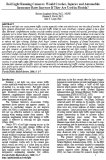3/12/2008
Report: Red Light Cameras Increase Injuries and Insurance RatesReport published in Florida Public Health Review journal finds red light cameras increase accidents and insurance industry profit.

An analysis published last week in the journal of the Florida Public Health Association argues that, contrary to common assumptions, the use of red light cameras leads to increases in insurance rates and injury accidents. Researchers Barbara Langland-Orban, Etienne E. Pracht and John T. Large closely examined the most often cited studies of red light camera use and concluded that not all of them were equally reliable.
"All research studies are susceptible to design flaws, especially observational (i.e. non-experimental) studies," the report stated. "Some of the major studies concluding reductions in red light running have exhibited such design flaws."
The most proper way to study the issue would be to gather accident data at intersections where cameras are actively ticketing over a set period (after) and compare them with accident records for an equal period when the devices were not installed (before). Control intersection data can then be used to better isolate the effects of camera use. Professor Orban and her colleagues found that the studies usually cited by photo enforcement proponents did not follow this basic procedure.
For example, Insurance Institute for Highway Safety (IIHS) study of accident reductions in Oxnard, California did not actually examine accidents at camera intersections. Instead, it compared citywide crash rates between intersections with signals and intersections without signals. Likewise, the Federal Highway Administration's (FHWA) 2005 study of cameras did not compare the accident rate before cameras were installed to the rate afterward. Instead, it estimated expected crashes in the after period by comparing intersections with cameras to intersections without.
FHWA also selectively excluded certain cities from its analysis, including Greensboro, North Carolina and cities in Virginia, which experienced a significant increase in injuries and accidents according to other studies. The report also selectively excluded the reporting of certain data to ensure independent researchers would be unable to challenge or verify the study's conclusion. The federal agency went to far in its secrecy as to refuse a Freedom of Information Act request for a set of its results listed by location. The National Motorists Association had made the request intending to verify the particular conditions at the intersections studied.
The researchers suggested that the IIHS and FHWA studies were tainted by financial conflicts of interest. The insurance industry directly funds IIHS. And, although the FHWA study was sponsored by the US Department of Transportation, study co-director Bhagwant Persaud has accepted significant payment from IIHS for his past research. Orban explained that the insurance industry not only makes money from traffic tickets that carry license demerit points, but it also makes greater profit when the number of accidents increases.
"Higher crash rates suggest higher risk; justifying higher premiums and profits," the report stated. "Due to the pricing methods used, automobile insurers do not have a financial incentive to lower crash rates or perceptions of risk."
The report cites Florida data from the National Association of Insurance Commissioners which shows that insurance profits skyrocketed from 2000 to 2004 -- from $8.7 billion to $14 billion. It did so by paying out 73 cents in claims for every dollar collected in premiums in 2000. This number dropped to 61 cents on the dollar in 2004. During this period, the accident rate remained static and the number of traffic tickets issued increased.
Orban found the independent VDOT, Ontario and Burkey-Obeng studies (view studies) followed proper scientific methods and were fully open in sharing the data upon which the conclusions were based. These studies concluded that red light cameras caused an increase in injuries and overall accidents.
"Cities and counties should... pursue engineering improvements to enhance intersection safety for all drivers and passengers," Orban's report concluded. "Proven engineering practices and countermeasures can reduce crashes and injuries due to red light running, as well as other causes of intersection crashes."
Read the full text of the report in an 80k PDF file at the source link below.


